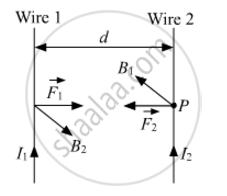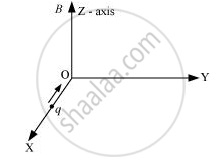Advertisements
Advertisements
Question
Two long, straight, parallel conductors carry steady currents, I1 and I2, separated by a distance d. If the currents are flowing in the same direction, show how the magnetic field set up in one produces an attractive force on the other? Obtain the expression for this force. Hence, define one ampere.
Solution
Magnetic field induction at some point P on wire 2 due to current I1 passing through wire 1 is given by
`B_1=(mu_0 2I_1)/(4pid)`

As the current-carrying wire 2 lies in magnetic field produced by wire 1, the unit length of wire 2 will experience a force, which is given by
`F=B_1I_2xx1=(mu_0)/(4pi) (2I_1I_2)/d`
According to Fleming's left-hand rule, the force on wire 2 acts in the plane of paper perpendicular to wire 2, directed towards wire 1. Similarly, wire 1 also experiences the same force towards wire 2.
Thus, both the conducting wires attract each other with the same force F.
Thus, one ampere can be defined as the amount of current flowing through two parallel conductors (in the same direction or opposite directions) placed at a distance of one metre in a free space, and both the wires attract or repel each other with a force of 2×10−7 Nm−1 per metre of their lengths.
RELATED QUESTIONS
Use this law to find magnetic field due to straight infinite current carrying wire.
A charge ‘q’ moving along the X- axis with a velocity `vecv` is subjected to a uniform magnetic field B along the Z-axis as it crosses the origin O.

(i) Trace its trajectory.
(ii) Does the charge gain kinetic energy as it enters the magnetic field? Justify your answer.
A charged particle is moved along a magnetic field line. The magnetic force on the particle is
A charged particle enters an environment of a strong and non-uniform magnetic field varying from point to point both in magnitude and direction, and comes out of it following a complicated trajectory. Would its final speed equal the initial speed if it suffered no collisions with the environment?
Consider a wire carrying a steady current, I placed in a uniform magnetic field B perpendicular to its length. Consider the charges inside the wire. It is known that magnetic forces do no work. This implies that ______.
- motion of charges inside the conductor is unaffected by B since they do not absorb energy.
- some charges inside the wire move to the surface as a result of B.
- if the wire moves under the influence of B, no work is done by the force.
- if the wire moves under the influence of B, no work is done by the magnetic force on the ions, assumed fixed within the wire.
At a certain place the angle of dip is 30° and the horizontal component of earth’s magnetic field is 0.5 G. The earth’s total magnetic field (in G), at that certain place, is ______.
With a neat labelled diagram, explain cyclotron motion and cyclotron formula.
State the expression for the Lorentz force on a charge due to an electric field as well as a magnetic field. Hence discuss the magnetic force on a charged particle which is (i) moving parallel to the magnetic field and (ii) stationary.
State dimensions of magnetic field.
